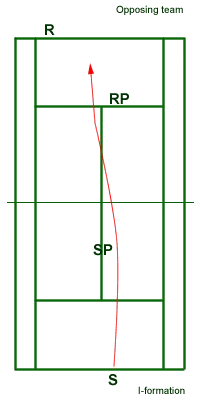This is another strategy used by the serving team where the server stands very close to the center mark to start the point and his partner who is at the net places himself on the center line, about halfway between the net and service line. So both, the server and his partner are in the same line, close to the center, hence the name of I-formation (see graphic below).

The serving team must communicate (before the point starts) their intention of whether the net player should move to the right or left right after the serve has been delivered. Obviously, these intentions must be kept secret and avoid being picked up by the receiving team.
To be successful in keeping their intentions away from the receiving team, the server and his partner should make their moves at a time that coincides with the ball bounce and just before the receiver makes contact with it. Moving too early can allow the receiver to change his return placement tactic. Making the move too late may result in late court coverage.
Net Player’s Position
To avoid being hit by the server, the net player should position close to the net (about 10 feet) and close to or on the center line, adopting a very low stance. The low stance should be comfortable enough so that he can spring into action as soon as the serve is delivered. I suggest that the stance should be with feet spread a little wider and the knees bent a little more than normal without over-exaggerating. After all, the net player’s main role in the I-formation is to poach the serve return. That means he should be able to explode quickly in either direction from his position.
Why use the I-formation
It takes advantage of the predictable cross-court service return that most players prefer to make. In the I-Formation, the net player is positioned to cut off just such a return while forcing the returner to guess in which direction he intends to move.
Server’s Role
The server’s role is to place the ball either down the T or into the receiver’s body. I would say that he should mostly hit the ball down the T because this tactic puts the net player right in front of the receiver. That cuts off the angles and makes it very hard for the returner to pass the net player.
So, serving down-the-T sets up the net player perfectly for a poach. Conversely, serving wide opens up the angles of return and makes the net player’s job difficult.
The Server should avoid hitting topspin serves because their high bounce can facilitate a return down to the net player’s feet. Slice or flat would work better considering they stay low and make the returner hit up.
How can the I-Formation be used:
As we discussed in the Australian formation, the server and his net partner can apply the following tactics:
1. The server stays on the same side, and his partner switches to the other side.
2. The server switches sides, partner switches accordingly.
3. The server moves up to the net on the same side, and the partner switches covering the other side.
4. The server moves up to the net switching sides, partner covers the other side accordingly.
Moving up to the net following the serve, most of the time is a great tactic considering that the receiver will be overwhelmed by all the things he has to watch: the ball, the net opponent, and the server.
So the I-Formation is a great tactic for serving and volleying and setting up poaching the return.